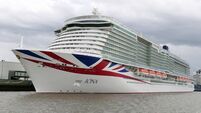Space officials hail Titan's pictures
European space officials offered sharpened pictures today from their Huygens probe on Saturn’s moon Titan, showing a pale orange surface covered by a thin haze of methane and what appears to be a methane sea with islands and a mist-shrouded coastline.
Scientists worked all night to refine the images, taken Friday as Huygens plunged through Titan’s atmosphere before landing by parachute on the surface.














